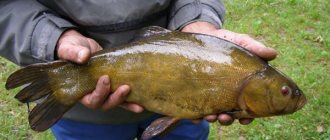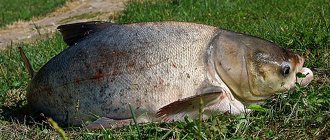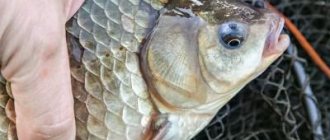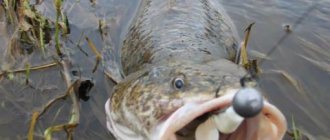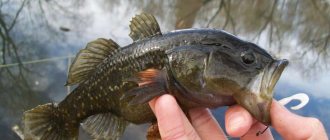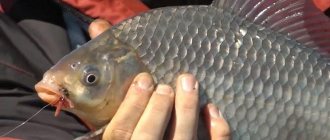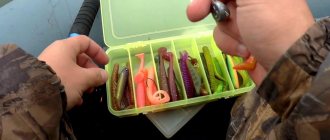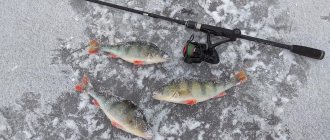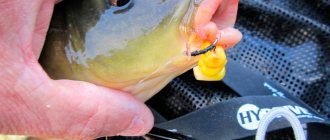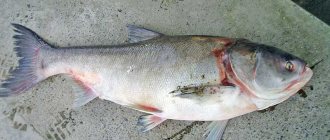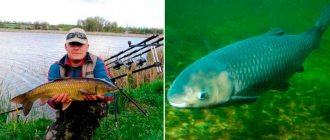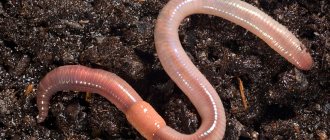Description and behavior characteristics
Tench belongs to the carp family; it is sedentary and calm. Undemanding to water quality, tolerates lack of oxygen well. It does not like bright light, and therefore prefers to stay near the very bottom. The body of the tench is multi-colored, the back is green-yellow, and the barrel is olive.
The scales are small, covered with viscous mucus on top. The fins are dark purple, rounded, and the eyes are small, bright red. It feeds mainly on green reeds, reeds, duckweed, and finds food in the bottom silt. It also eagerly eats: aquatic insects, worms, leeches, larvae, mollusks, crustaceans, and fry.
In summer it feeds only at dusk and at night.
Average weight from 300 gr. up to 2 kg, but there are also 7 kg individuals. When the water warms up to 14° C, spawning begins, somewhere from May to July, it does not migrate. It accumulates in small groups only in wintering areas or during the spawning period.
When the reservoir freezes and the summer drought occurs, the tench buries itself in the silt and falls into a long-term torpor. It can only be detected by air bubbles on the surface of the water, at dawn or in the evening. With the onset of persistent frosts, they stop feeding and freeze in mud pits until it warms up. It is preferable to hunt for it in the warm season; at other times there will be no bite.
Habitats
Inhabits: Eurasia, lakes and rivers of the Baltic, Black, Caspian and Azov seas. Found in the Baikal basin, in its western part. In the upper reaches of the Yenisei and Ob. Lives: lakes, ponds, river bays, channels, reservoirs, etc.
It prefers a silt-clay bottom, and an abundance of underwater and aquatic vegetation: water lilies, duckweed, egg capsule, reeds, pondweed, reeds, cattails, etc. It prefers reservoirs with standing water or weak currents.
Tench never changes its habitat , but has its own areas known only to it, to which it always returns. An observant fisherman can detect it: by the swaying of the stems on the water, air bubbles, cloudiness of the water, etc.
Peculiarities of tench biting by season
- Winter. In winter, she does not feed, but is in deep hibernation. Therefore, it is not possible to catch it at this time.
- Spring . With the arrival of spring, he will come to life and, when hungry, will rush to any food offered to him. But a particularly favorite delicacy for him: bloodworms, bell larvae, and red worms. By mid-May, the bite will subside, and then stop completely before spawning. It will resume in 2 weeks because summer is starting.
- Summer. A favorite time for fishermen, because the catches are stable and it’s warm. On particularly hot days, the bite will only be after sunrise, or late in the evening. But only night fishing can be especially catchy. For bait, various baits are used: vegetable, animal. Which ones exactly will depend on the taste preferences of aquatic inhabitants.
- Autumn. You can fish throughout the entire fall with varying success, right up until the leaves fall. A good bite occurs in cloudy but warm weather with drizzling rain. But when incessant rains begin, not even the most attractive bait will be able to lure the tench out of the depths. At the beginning of autumn it is better to use plant baits, but in October switch to animals: bloodworms, worms, slugs, snails, maggots, etc.
Tench bite on a float
Some people think that the peculiarity of catching tench with a float rod is its long and tedious bites. No – what’s more important is tactics, location, bait, and a systematic approach to fishing. And the tench vole can really be boring - just like the crucian carp. Most often this happens in the middle of summer, when the fish are well-fed and capricious, since there is a lot of natural food around. The tench then literally feasts on itself and tries the bait. During periods when the fish is actively restoring or accumulating its supply of nutrients - in June, August and September - the bites are often not just ordinary, but also aggressive, like that of perch. He just took it and dragged it into the bushes.
Catching tench with a fishing rod is not easy in terms of tactics, finding a place, bait and bait. But, if everything is done correctly, then no magic is needed. This fish is caught using the simplest amateur gear.
Subscribe to the channel:
YouTube channel RYBAFAN
We are VKontakte
Tench fishing methods
There are many ways to catch this difficult fish, but the two most popular are: a float rod and a feeder tackle. You can fish from a boat or shore, but it is more comfortable from a boat. And it will be easier to change the place if necessary.
Float rod
Fly tackle
It is necessary to choose a place for future fishing, and based on the characteristics of the reservoir, we begin to equip the fishing rod. For fishing from a boat, from the shore, in an overgrown reservoir, use fly tackle :
- rod—4–7 m;
- high-quality monofilament line - 5.5–6.5 m, Ø 0.21–0.30 mm;
- hook - N°7–10;
- float load capacity - 2–2.5 g;
- subpastor - 0.5 g;
- nylon leash - Ø 0.16–0.20;
- 2-3 pellets - 1 g each.
Match equipment
A match fishing rod is used in unpolluted reservoirs, its equipment:
- rod with rings - 3.4–4.5 m;
- spinning reel - 2000–3000;
- monofilament - Ø 0.20–0.27 mm;
- hook - N°6–10;
- sliding olive, made of lead -2–4 g;
- fluorocarbon leash - Ø 0.13–0.18 mm, length 20–30 cm;
- subpastor - 0.5 g;
- float of bright colors - 4–5 g.
Feeder tackle
It is assembled from the following components: feeder, rod, fishing line, reel and leash with hook. The set always begins with choosing a feeder.
It is better to acquire several models at once, of different weights and sizes:
- For the current you will need weighted ones, preferably triangular or square in shape. To cast the equipment 60–80 m, you will need 80–100 g of feeder.
- Without current - light, round or oval, for distant casting you will need a 60-80 g structure.
The rod is selected for fishing conditions, the test load should be in the following range: the total weight of the feeder plus bait should not exceed the upper permissible threshold, if the weight of the feeder is 40–50 g, plus 20–30 g of bait, then the test is in the range of 50–110 G.
We select the length based on the casting distance and the activity of the water flow:
- calm waters - 3.3 m;
- leisurely waters - 3.6–4 m.
Equipment:
- reel 3000, gear ratio 1:5, 1:6;
- fishing line (braid) Ø 0.13 mm;
- leash - a piece of monofilament Ø 0.19 mm;
- hooks - No. 5-6 for small bait for grains, etc., and No. 7-10 for larger bait: maggots, worms, worms, corn, etc.
To make the feeder equipment more sensitive, it is necessary to combine the feeder with the main fishing line. This can be done in different ways: anti-twist tube, Gardner equipment, loop equipment, etc.
Baits and lures
Baits and lures are used to attract fish to the hook. This can be food: animal, plant origin, or imitation food.
The choice will depend on:
- features of the reservoir;
- season;
- fishing place;
- type of fish;
- depths;
- indicators of atmospheric pressure, etc.
The main condition is that the bait should look tempting, and the tench should not notice any catch. Now let's take a closer look.
Animal origin
When choosing, take into account the tastes of the fish, and it prefers animal bait most of all. Those that can be found during this period of time are especially valuable. In summer, for example, worms will be very good, just drip them near the river. It can be extremely difficult to please this fish; you only need to adhere to the naturalness of the diet:
- Various worms (earthworms, dung worms, etc.) are best, especially in a bunch of 2-4 pieces, the hook point should be completely covered.
- Maggots are small, grown on vegetables or meat. 1–7 pieces are pinned onto the hook at once, depending on the fishing method. The sting should not protrude too much, otherwise the tench may refuse the treat after being pricked.
- Shitik - if there are flowing streams, then there are shitiks. Put on 1-3 pieces so that the sting is not visible. His only drawback is his quickly deteriorating body, and the other fish lads adore him, so they quickly eat him up.
Bark beetle larva
Muckworm
Maggots (attachment options)
Dragonfly larva Ant eggs
Shell meat - In the green reeds there lives a green soft larva , reaching up to 4–5 cm; moults simply adore it.
- The larva of a dragonfly - but only a large tench can encroach on it. They are inserted between the skull-shaped jaws, and the sting is brought out from the bottom of the abdomen. It should not stick out much, but when touched, it should be slightly felt with your finger.
- Shellfish meat (shells, pond snails, pearl barley, etc.) - is caught in places where mollusks accumulate, the hook tip must be completely drowned in the fleshy part.
- Larvae of bark beetles - in fallen trees flooded by spring waters, beetles lay larvae, which are an excellent bait. They string 2–4 pieces, the sting is masked.
- Ant eggs - put on 5-7 eggs, pressing down the sting.
- «Sandwiches» - combinations of attachments:
- bloodworm - mollusk;
- maggot – worm;
- shitik - ant eggs, etc.
Curd bait
If you have cottage cheese in the refrigerator, then prepare a cottage cheese bait:
- missing cottage cheese 300 gr.;
- sunflower cake 600 gr.;
- breadcrumbs 500 gr.;
- a handful of peat;
- flavorings (any of your choice).
Mix all the ingredients well, then form small balls.
Plant-based: recipes
1 recipe:
- canned corn – 0.5 cans;
- breadcrumbs – 1–1.5 kg;
- hemp seeds – 200 gr.;
- cocoa powder – 40 gr.;
- sugar – 3 tbsp. l.;
Mix the dry ingredients, then the rest, bring to the desired consistency with water.
Recipe 2:
- semolina – 0.5 kg;
- corn grits – 0.5 kg;
- cake – 0.5 kg;
- oat flakes – 0.5 kg.
Mix and let it brew for half an hour; upon arrival, add a little water from the reservoir.
Recipe 3:
- pearl barley;
- peas;
- millet;
- some homemade butter;
- 1 tbsp. l. honey.
Cook porridge from cereals, the main thing is to make sure it doesn’t burn, then add butter and honey.
Float equipment for line
To catch tench with a float rod, you need reliable, strong, but at the same time sensitive equipment. A tench caught on a fishing rod in summer stubbornly resists, pulls into the reeds, tends to bury itself in the mud or lie down in the mud. Sometimes you have to force the fishing so that the fish does not completely drag the fishing rod into the thicket. At the same time, the bite of the tench is often long and weak - small pokes, sinking, and pulling the float to the side a few centimeters. Therefore, we use sensitive small floats to record every micro-movement of the hook.
fishing line
Monofilament fishing line for tench in our conditions, when a fish weighing 600-700 grams is considered large - 0.2 mm. Diameters of 0.25-0.3 mm are advisable to use if the tench in this place is obviously large, a kilogram or more. We don’t put leashes on so as not to weaken the tackle. If the tench has already approached the point and is feeding, then it is not even afraid of a thick fishing line among the plants. Because he’s used to getting food in conditions of a lot of thickets, twigs, and mud. For small molts, you can use a thinner fishing line. 0.18-0.16 mm - only if the angler is sure that he will not miss the bite and will not allow the fish to enter the reeds.
Float
As already noted, we use a small float for tench, no more than 3 grams of carrying capacity. When fishing in shallows, it is also necessary that the float does not have too bright cambrics or stripes - this can alert the fish, and it will not suit the bait. Therefore, the best and proven option is a feather float. We load it in such a way that when fully loaded it protrudes out of the water by 2-3 cm. If we put the feedstock on the bottom - by 4-5 cm.
- In general, the approach to loading is the same as when catching capricious crucian carp. As soon as during the bite the angler understands that the fish is holding the bait in its mouth, and is not chasing it back and forth, we set the hook. This is expressed in the constant movement of the float to the side, immersion or laying out on the water. But for now, poking, pushing, short movements to the side - we are waiting.
- If we use a regular float with an antenna, we surround it according to the same principle. When fully loaded, only the antenna (or part of it on a float with a long antenna) should stick out of the water. We put the pad on the bottom so that the body of the float barely rises. When it rises, the float will come out even higher.
- But this is only on a flat bottom at a point. More often than not, it's full of mud. The hook with bait may not be at the bottom, but hang on the mud next to it. It doesn’t matter - the tench is used to looking for food among such writhings. He will find bait - as long as it is attractive. However, on very soft mud, you need to either carefully adjust the depth, or hang a piece of foam on the hook so that the bait does not sink into the mud and is immediately visible to the fish.
Hooks
In principle, there are no line hooks - we use, for example, as for crucian carp of the appropriate size. However, experienced fishermen select the size and configuration of the hook not for the fish, but for the size and type of bait. A good hook will hook fish, both large and small, equally well. What is more important here is the quality of the hooks themselves - they must withstand rough fishing and forced fighting with fish.
Nuances of bait
In order for the tench to peck well, you need to feed the same place for several days. Only in small water areas, this fish can bite after the first bait. Much will depend on the time of year, day, and weather conditions. Shallow water areas, at the edge of reed thickets, in a “window”, etc., are most suitable for feeding.
You cannot feed with heavy balls, because the bottom is usually covered with a layer of silt or greenery, and when they sink into them, they become invisible. It is more advisable to prepare a loose mixture from crushed components, but it should consist of large fractions. Its slow immersion promotes attachment, and the fry will not be able to eat it.
It is better to introduce a little, but with nutritious bait, than a lot, but “empty”. Only targeted feeding can give the best results. It is advisable to enrich plant baits with a “meat” additive: maggots, worms, crawlers, pupae, etc.
Places of attachment must be inspected regularly. Approach the shore or swim up on a boat and see whether the bait has disappeared or not. If it is shallow and the water is clear, it will be clearly visible. If the water is deep and opaque, then only by the characteristic air bubbles can one find out whether the tench is feeding or not.
With your own hands
Recipe No. 1:
- any bran 1 kg;
- boiled semolina, a little;
- boiled or steamed millet 0.5 kg;
- a handful of chopped worms.
Recipe No. 2:
- sunflower cake;
- breadcrumbs;
- hemp oil 2-3 drops;
- grains, any (steamed).
Mix everything in equal proportions and leave for 1-2 hours.
Recipe No. 3:
- fry rolled oats;
- boiled potatoes;
- White bread;
- peas (steamed).
The proportions are arbitrary, soak the bread and mix with all the ingredients.
Shop
In fishing stores you can always buy ready-made baits suitable for all types of fishing.
If you don’t find a molt, use another: carp, crucian carp. The main thing is that the bait is suitable for standing water; read the information on the pack.
A spring or method feeder is often depicted on the packs. You need to choose only dark baits so that they blend in with the muddy bottom. Contains: rich in proteins and betaine, and many other nutrients.
Habits of tench and its habitats
In fishing slang they call it a pig, this is probably due to its lifestyle. Although some believe that such a nickname suits her, since tench lives in conditions that cannot be called favorable. It is known that tench, like many other fish, leads a schooling lifestyle and when one fish is caught, another bite of the same may follow. Tench gathers in flocks with its brothers, with those with whom it grew up and ate together. This may yet be its distinguishing feature.
If you come across a school of tench and they are not very large in size, then do not be upset, perhaps on your next fishing trip you will be lucky and large individuals will bite. It has been noticed that large and small individuals of this species differ significantly in their behavior patterns. The difference in behavior is associated with attentiveness and caution, namely, large individuals are more careful, but small animals of the same species are not at all afraid of various noises on the surface of the reservoir and do not react to the movements of fishermen along the reservoir or on it (fishing from a boat).
Catching large tench involves a long wait, you also need bait, and you also need special gear for this type of fishing. But small tench can always be found in shallow water, overgrown with grass or water lilies, only in some cases it can be fished out from the depths, what is the reason for this, a possible reason for this phenomenon is a change in the weather.
Before fishing, fishermen have a thought or goal about where they will fish. Having settled on the shore with gear, the fisherman adheres to the same signs, and they have the presence of grass and water lilies, as well as depth. It is also worth taking into account the fact that tench bite well in the early morning, and if the fishing spot is also fed, the bite will become stable and effective.
Tench fishing techniques and tactics
- To begin with, it is advisable to locate the place of fatting; if clusters of small bubbles appear on the surface of the water, it means that tench has arrived.
- Its location can also be determined by ear; when it licks larvae from algae, a characteristic smacking sound is heard.
- The most popular baits: crawlers, shell meat, worms, maggots, bloodworms, chafer larvae. Vegetable: peas, semolina porridge, corn. Don't forget the bait: chopped worms, shell meat, crackers or bran.
- You can’t talk loudly on the shore, stomp, cast a shadow on the water, or noisily struggle with hooks.
- The bite can sometimes last up to 10 minutes. At first, the float simply twitches and it seems that it is about to go under water. But this doesn’t happen, he just tries it out. Then everything calms down, and after 30–40 seconds it repeats again, and so on several times in a row. When the tench finally decides to grab the bait, you need not to yawn and make a sharp hook.
- If hunting is carried out from the shore, clear a path in the seaweed for fishing in advance.
What does tench bite on, how to lure it
Tench feed on small crustaceans, mollusks, worms and other invertebrates. He loves microscopic daphnia. All this should be included in both the bait and the bait.
Effective baits and tench always bite on them are earthworms and other worms, slugs, bloodworms, shrimp, maggots.
In some places, but not everywhere, vegetable baits such as bread, pellets, corn, carp boilies, green peas can work.
Adding plant elements to bait only attracts tench and arouses its curiosity; in the absence of an animal component, it will most likely quickly leave. In the spring, bait that includes hemp seed or cake works.
Unlike carp, if a tench approaches your bait, it will quickly decide to try it, so you won’t have to wait for hours for a bite.
We recommend: How to get rid of mosquitoes while camping, fishing and outdoor recreation
He either came up and will feed, or you chose the wrong place.
Universal bait:
Bait for tench
Ground crackers from black bread, with the addition of corn and chopped worms, you can add live maggots.
Tips and tricks
Basic recommendations and useful tips:
- If there is no bite for a long time, try an effective remedy : cut out a small piece of grass along with the turf, put 3-4 worms or maggots there, wait until they dig in there and use the bait for its intended purpose.
- To prevent maggots from turning into pupae in hot weather , wrap the container with wet rags.
- If you plan to fish on a sticky, swampy bottom , where the hook and bait can be immediately absorbed by quagmire or silt, we recommend attaching a small piece of foam plastic painted in any dark color 3–5 cm from the hook.
- At first, you can feed in large portions so as not to make any more noise.
- Tench never stay in one place for a long time; even a small pressure drop or a change in wind leads to the cessation of fishing, even in a place that has been fed for a long time.
